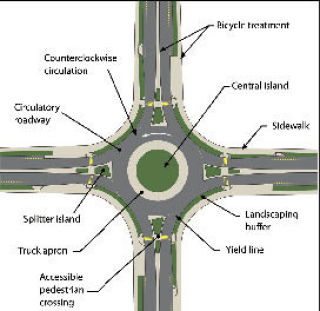Lea Hill’s new,
cost-effective
traffic circle
to help ease traffic
If you want to use the new traffic roundabout at the intersection of Southeast 304th Street and 124th Avenue Southeast, here’s the simple rule: incoming drivers yield to what’s in there.
And don’t panic – the center island, ringed by a truck apron, provides plenty of space for buses and emergency vehicles.
But since the Lea Hill roundabout is the first of its kind in Auburn, local drivers are bound to experience a bit of a learning curve.
King County began work on the project July 15 and expects to open it Tuesday, just in time for the start of school the following day. The county project predates the City of Auburn’s annexation of Lea Hill, which became effective Jan. 1, 2008.
“It is not complete; we will still have landscape and other issues to deal with, but it will be functional,” said King County Project Manager Donald Bleasdale.
Replacing the old four- way traffic signal, the roundabout moves vehicles through the intersection without a signal by directing them counterclockwise around the center island, rather than requiring a full stop.
There are several advantages to such a setup: traffic continues flowing without backing up; the intersection can carry 30 to 50 percent more vehicles than like-sized intersections during rush hour; and with a posted speed of 15 miles per hour, any accidents that do occur should be much less severe.
Roundabouts also cost less to maintain than signaled intersections.
“It just gives us a better level of service than the signal did,” Bleasdale said.
Given the many housing developments that have sprung up on Lea Hill in the last 10 years and the 2005 opening of nearby Auburn Mountainview High School, it should come as no surprise that the intersection had been overtaxed, especially during the morning and afternoon commutes.
Engineers began looking at alternatives three years ago. The first option would have added left-turn lanes on all four approaches, and a right-turn lane for traffic turning from westbound South 304th onto north bound 124th Avenue. The second option was a single-lane roundabout in the European tradition.
Bleasdale said that based on costs, the price of additional right of way for the additional turn-lane option, and environmental mitigation, the roundabout just made better sense.
Auburn Transportation planner Tiffin Goodman explained that the roundabout differs from the more common traffic circle, which is a small, raised island in the middle of low-volume, residential intersections to slow traffic down. It also is much larger, controlling traffic moving through high-volume intersections in place of traffic signals.
Auburn has four traffic circles, and two more planned sfor Lea Hill.
“Roundabouts were created in Europe, but if you talk to various aficionados of roundabouts, some would say what we have out there is not a traditional European roundabout,” Bleasdale said.


